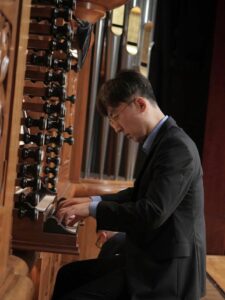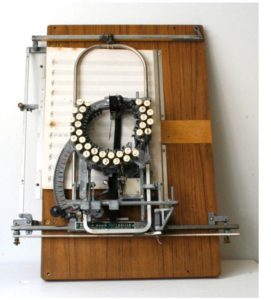聖誕節的意義重大,這段時間管風琴家通常也會排滿演奏檔期,因為管風琴長久以來就是基督教音樂的主要樂器,而聖誕節是基督教最重要的神聖節慶之一,此時大家都會期待聽到管風琴奏出撼動人心的樂曲,包括莊嚴雄偉又傳遞喜樂的聲音,以及溫馨的催眠曲或搖籃曲。其中最震撼的則是整座大管風琴如雷貫耳的聲音。管風琴特別適合肩負這項任務,因為它有充裕的氣流供應加上許多音栓的輔助,不過管風琴無法獨自創造出如此令人驚奇的體驗,它的音響環境,也就是所在的空間,對於發出的聲音的優美和音量也有極大的貢獻。然而,要在大教堂和音樂廳這樣的大型建築裡創造出如此雄壯又有力的聲音,其實是相當大的挑戰,因為要製造出極大的音量才能充滿整個空間。
現今的管風琴學生很常在音樂學院和學校的練琴室接觸小型管風琴,也有一些職業管風琴家在家中設置管風琴以便自行練習。幾百年以來,有許多室內管風琴為了住家或小型音樂廳而建造,但迄今為止大部分的管風琴都是在巨型空間中使用的,包括大教堂和會議廳在內。這些管風琴的用途各有不同,包括為歌唱家伴奏、獨奏演出、與管弦樂團搭配等;除此之外,建造者也思考如何設計出既可靈活運用又能讓大型空間充滿音樂的管風琴。這項工作並不容易,解決問題的方法各異而且可謂充滿巧思,不同國家的管風琴各有特色,展現出建造者用來應付挑戰的巧妙方法。我們雖然無法探究不同的管風琴建造學派應付這個問題的所有具體細節,但至少可以簡略瀏覽歐洲各地的管風琴,一窺從古至今的管風琴建造者曾經運用哪些方法。
啟程之前,我們需要先用一點時間看看大型管風琴所在的空間。最早的教堂是用大塊岩石和石板造的,厚實的石材甚至可以防止最長的低音波傳到室外,而且許多放置管風琴的室內空間長達數百公尺、天花板也是高聳參天。寬敞的容積讓聲音能在室內飄送迴盪,經由牆面、天花板和地板發出迴音。這些音響空間的大小和質地會擴大管風琴的自然音量,使聲音在管風琴家彈奏完畢後徘徊在空中幾秒鐘。因此管風琴送出樂曲的最後一個和音後,聽眾會聽到音樂在整個空間裡迴盪,穿透到空間的另一端並傳送到遠方。例如在歐洲最大的教堂裡,管風琴的殘響可以維持8秒鐘甚至更久。一般而言,與管風琴建造家合作的聲響專家(聲音工程師)會考慮讓殘響至少維持3秒鐘,使聲音具有生命力,而不會像是幾乎沒有殘響的空間那樣令聲音變得太「乾」。
從18世紀開始,管風琴建造者也要面對在音樂廳建造管風琴的問題。音樂廳的建築形成的挑戰完全不同於充滿迴響的教堂,但建造者仍然借用教堂管風琴大部分的設計概念。因為音樂廳是多種樂器的表演場地,例如管弦樂團,所以殘響量通常略少於大教堂,而且裡面的管風琴需要能夠與大型管弦樂團合作兼競爭,需要範圍廣大的各種聲音和力度,因此這些管風琴都相當龐大,往往多達甚至超過100個音栓。
管風琴建造家是怎麼滿足各種不同音響空間的要求的?一般來說他們只有兩種選擇,一是改變氣流,一是改變音管寬度。要讓管風琴發出更大的聲音,看起來最簡單的方法自然是增加風壓,但這種做法一直到18世紀後半才廣泛採用,一部分是因為這會導致音管容易走音。而第二個方法(改變音管寬度)包含幾個選項,從增加音管的形狀和數量,到改變發聲和調整音準的方法。但我們還是得記得,管風琴愈大,費用就愈昂貴,因此音管數往往受限於能夠投入的經費。
出發之前必須再次強調的是,限於時間,我們這趟行程不可能參觀讓管風琴的音樂能夠填滿整個空間的每個創新之舉,只能簡略看過幾個例子和方法。最早發展成熟的管風琴(至少以有幾組鍵盤和音栓的現代管風琴而言)看起來是源自低地國,也就是現在的荷蘭還有比利時北部。所以我們就從那裡開始,看看荷蘭人如何設法讓管風琴的聲音充滿整個大教堂。
來到低地國就會發現,管風琴建造家的做法是加倍高音部音管的排列(附圖1),尤其是基礎音栓或主音管音栓。這代表什麼呢?在某幾排音管中會有一些音管兩兩相連,彈奏某個音符或音調時,就從鍵盤中段向外側一同發出聲音。運用加倍的主音管家族齊奏音栓的組合設定,讓它能發出更大聲、更宏亮的聲音。這不只可以強化鍵盤的高音部,而且會讓高音部(通常是主旋律)更清楚,在大型空間中更容易聽見。到了18世紀,主音管家族齊奏的組合音栓方式逐漸成為帶領大批會眾唱詩的必要方法,現在如果聽到一大群人跟著管風琴吟唱,還是可以聽出這種效果。
我們很容易藉著觀察荷蘭管風琴的外觀而看出哪些管列是加倍的。我們可能會看到較低處的音管上下顛倒,底部向上對著較高處音管的底部。看到這些音管時,會覺得這些音管彷彿成為彼此的倒影或鏡像(附圖2)。即使從外觀看不到倒置的音管,只要仔細聆聽不同音栓組合的聲音和音調,還是可能聽出哪幾排是加倍音管。由於要讓齊奏音管完全同調是極為困難的事,我們只需要注意聽出不同音調的音管,或是一些似乎出自單一音管、發聲時間卻有些微差異的聲音就能分辨。(待續)
“Making Itself Heard: The Many Voices of the Organ” (part I)
Among other things, Christmas is a time of year when organists are traditionally in high demand. This is mostly because the organ has long been the main instrument for Christian music, and Christmas is one of Christianity’s most significant holy days. At Christmas time, people have come to expect powerful music from the organ, music of grandeur and joy, as well as lullabies and cradle songs. But still, nothing is more impressive than the sound of full organ washing over our ears. Of course, the organ is especially well-suited to this task because of its capacious wind supply and many stops, yet the organ alone cannot create such an amazing experience. Its acoustic environment, the room in which an organ stands, also contributes greatly to the beauty and volume of the instrument. In large buildings, such as cathedrals and concert halls, however, creating such a grand and powerful sound has proved seriously challenging because the volume of space to be filled can be so enormous.
Today, organ students are used to finding small pipe organs in conservatory and school practice rooms, and some professional organists even keep such instruments at home for private practice. Over the past few centuries, there have also been numerous chamber organs built for homes or small concert halls. But by far, the majority of organs have been built for giant spaces, from cathedrals to convention centers. Besides the various purposes of such organs — accompanying singers, performing solo pieces, playing with orchestras — builders have also thought how best to design instruments that are both flexible and yet capable of filling large spaces with sound. This has proved a difficult problem, which has been solved in many different and ingenious ways. Indeed, the various organ designs found throughout different countries demonstrate the many methods builders have used to meet this challenge. While we cannot look at every detail of how different schools of organ building have answered this question, we can at least take a brief tour of organs throughout Europe to examine some of the solutions that builders there have tried throughout history.
Before setting off on our journey though, we need to spend a little time looking at the large rooms where organs live. The oldest churches were made from huge boulders or slabs of stone. This kind of thick stonework prevented even the longest bass sound waves from easily escaping a room, and many of those rooms were hundreds of meters long with ceilings high above the ground. Such generous dimensions allowed sound to roll around a room, echoing off walls, ceilings and floors. The size and qualities of these acoustic spaces magnified the natural volume of the organ, allowing sounds to hang in the air for several seconds after the organist finished playing. So upon releasing the final chord of a piece, the organ’s voice could be heard traveling throughout the length of a room, echoing away into
the distance. In some of the largest European churches, for example, this reverberation can last up to 8 seconds or more. Generally, acousticians (sound engineers) working with organ builders consider a reverberation time of at least 3 seconds to be ‘lively’, rather than ‘dry’, as is true in rooms with barely any reverberation at all.
Beginning from the 18th century, organ builders also faced the problems of building organs in concert halls. These buildings presented builders with a different set of challenges than reverberant churches, yet builders still borrowed the majority of their designs from church instruments. Because concert halls were intended as performance spaces for large groups of instruments, such as orchestras, the amount of reverberation was usually somewhat less than in large churches. Also, organs built for such rooms needed the ability both to collaborate and compete with large orchestras. Because this required a large range of sounds and dynamics, these instruments grew to be remarkably large, often nearing or even surpassing 100 stops!
So, how have organ builders met the demands of all these different acoustical spaces? In the most general terms, they have only had two options: change the wind or change the pipes. Though it seems natural that the easiest way to make an organ louder is to increase its wind pressure, this approach was not widely accepted until the later 18th century, partly because of the difficulties it created for voicing pipes. The second solution, on the other hand — changing the pipes — offered several options, from increasing the shape and number of pipes to changing the way they are voiced and tuned. Still, we have to remember that the larger the organ, the more expensive it can be, so the number of pipes is often limited by the money that is available.
One final point must be repeated before setting off on our journey. We cannot take time on this trip to visit every innovation that enabled the organ to fill vast rooms, so we must be happy with simply looking at a few examples and methods. The earliest examples of fully developed organ building, at least in the modern sense of an instrument with multiple keyboards and stops, appear to have originated from the Low Countries, what we today call Holland and parts of northern Belgium. So, let’s begin there and look at the Dutch solution to the problem of filling large churches with sound.
Traveling to the Low Countries, we discover that builders there had a practice of doubling the treble registers of pipe ranks, particularly principals (sometimes called Praestants). What does this mean? For some rows of pipes, there were two unison pipes speaking for
each note or key that was played, starting from the middle of the keyboard. The use of two pipes helped strengthen the treble range of a stop by giving it a somewhat louder and larger sound. This was useful not only for reinforcing the higher notes of the keyboard, where the quality and strength of the sound started to fall off as the organist played higher and higher notes, but also for making the soprano voice (which was often the melody) clearer and easier to hear in a large room. By the 18th century, the practice of doubling trebles was considered a necessary means of leading large groups of people when singing. We can still hear their effect today by listening to people singing along with those organs.
Sometimes in Dutch organs, it is easy for us to see which ranks are doubled by simply looking at the façade. We can see where lower flats of pipes may be turned upside down so their feet point up toward the downward-facing feet of the pipes in the higher flats. When we look at these pipes, we feel as if the pipe flats are reflections of each other, or mirror images. But even if we cannot see inverted pipes in the façade, it is still possible for us to hear which ranks are doubled by listening carefully to the speech and tuning of different treble registers. Since it is notoriously difficult to keep doubled ranks in tune, we only need to listen for pipes that are either out of tune, or for sounds that seem to come from a single pipe but that speak from two different sources at slightly different times. (To be continued)
Your Friend,
Justin





